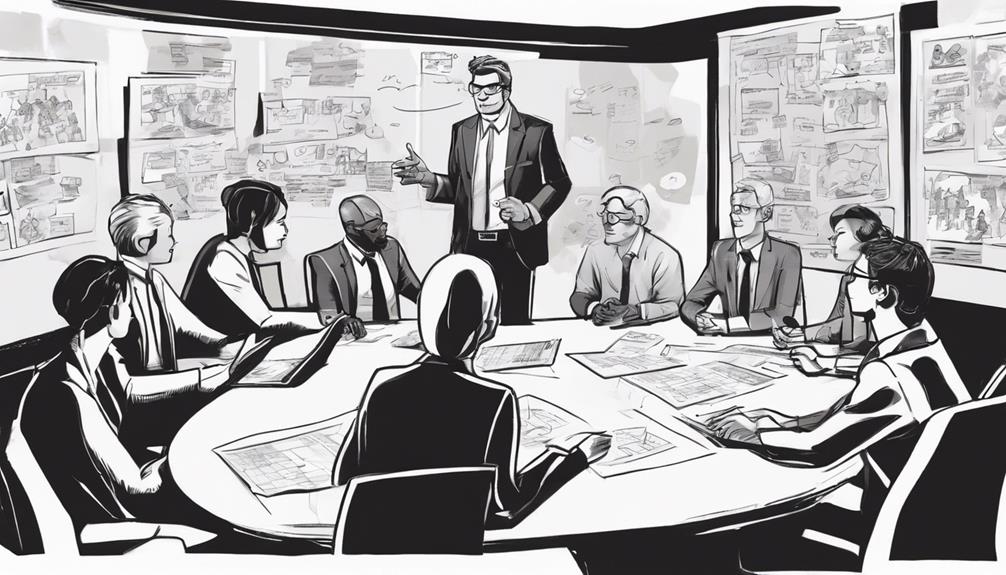Mastering the art of team building is essential for your organization's success. Start by clearly defining team roles and matching individuals to tasks that play to their strengths. Effective delegation allows you to focus on strategic goals while fostering collaboration. Encourage open dialogue and regular check-ins to boost morale and improve team dynamics. When conflicts arise, address them promptly through open communication, where everyone feels safe to share their views. Cultivating a supportive environment will enhance trust and commitment. There's so much more you can do to elevate your team, so keep going to explore additional strategies! Consider implementing strategies for outsourcing product development to enhance your team’s capabilities and expand your organization’s reach. By leveraging external expertise and resources, you can accelerate innovation and streamline your time-to-market. Collaborating with global partners can also bring fresh perspectives and diverse skill sets to the table, ultimately driving your team towards greater success. Keep an open mind and be willing to explore new opportunities for growth and development.
Key Takeaways
- Invest in understanding each team member's strengths to optimize task assignments and enhance overall productivity.
- Foster open communication and regular feedback to build trust and improve team dynamics.
- Set clear expectations and goals, ensuring everyone is aligned and understands their roles.
- Encourage collaboration through team-building activities that promote unity and shared purpose.
Importance of Team Building
Building a strong management team is essential for your business's growth, as it allows you to delegate responsibilities and focus on strategic decision-making.
Trying to oversee all operations solo isn't sustainable; you'll quickly become overwhelmed. High-level managers play important roles in critical business areas, ensuring everything runs smoothly.
By matching team members to roles that align with their strengths, you create a more effective and productive environment. Effective hiring can also help fill gaps where you might have weaknesses, enhancing overall performance.
When you invest time in building a solid management team, you empower yourself to concentrate on long-term goals, fostering innovation and growth, ultimately driving your business towards success.
Essential Team Roles

Identifying the right team roles is essential for optimizing your management structure and ensuring each member contributes effectively to the organization's success. Each role brings unique strengths that enhance team dynamics and performance. Here's a quick overview of essential roles:
| Role | Key Responsibilities | Essential Traits |
|---|---|---|
| CEO | Overall strategy and decision-making | Strategic thinking, leadership |
| COO | Manages daily operations | Efficiency, organizational skills |
| CFO | Financial planning and health | Analytical, detail-oriented |
Executive Recruitment Strategies

Effective executive recruitment strategies are essential for attracting top talent that aligns with your organization's goals and culture.
Start by leveraging your network and industry connections; referrals often yield the best candidates.
Consider partnering with specialized recruitment firms, as they can provide pre-screened talent and access to passive candidates.
Attend industry events to engage with potential hires directly, showcasing your company culture and vision.
Focus on quality over quantity when evaluating candidates; prioritize those who bring unique insights and experience.
Tailor your job descriptions to reflect the specific skills needed for your executive roles, ensuring clarity.
Evaluating Executive Candidates

When evaluating executive candidates, it's important to focus on both their skills and how well they fit within your company culture. Strong candidates not only bring expertise but also align with your values and vision.
Here are key aspects to contemplate during your evaluation:
- Assess role knowledge: Confirm they understand their responsibilities and industry nuances.
- Evaluate chemistry: Trust and rapport with your team can't be overlooked.
- Gather feedback: Insights from former colleagues can reveal cultural fit and performance history.
Effective Delegation Practices

Delegating tasks efficiently allows you to focus on strategic priorities while empowering your team to take ownership of their responsibilities.
Start by identifying strengths within your team; assign tasks that align with each member's skills and interests. Clearly communicate expectations, deadlines, and desired outcomes to guarantee everyone understands their roles.
Trust your team to deliver, but maintain open lines of communication for support and feedback. Regularly check in on progress without micromanaging, allowing your team to grow and learn from their experiences.
Recognize achievements to motivate and reinforce a sense of accountability.
Enhancing Team Dynamics

Fostering strong team dynamics requires intentional efforts to build trust, communication, and collaboration among members. You can enhance these dynamics by actively engaging with your team, creating an environment where everyone feels valued and heard.
Here are some effective strategies:
- Encourage open dialogue by regularly checking in and soliciting feedback.
- Promote shared goals to foster a sense of unity and purpose.
- Recognize individual contributions to boost morale and motivation.
Conflict Resolution Techniques

Effective conflict resolution techniques can transform disagreements into opportunities for growth and collaboration within your team.
First, encourage open communication by creating a safe space for all team members to express their views. Listen actively to understand differing perspectives, and validate each person's feelings.
Next, focus on the issue, not the individual, to prevent personal attacks. Collaboratively brainstorm solutions that address everyone's concerns, making certain each voice is heard.
When necessary, bring in a neutral mediator to facilitate discussions.
Finally, establish clear agreements and follow-up to guarantee commitments are met.
Conclusion
So, you think you can run a successful business all on your own? Good luck with that!
Team building isn't just a buzzword; it's the secret sauce to your company's success. By embracing collaboration and filling those essential roles, you'll transform from a frazzled leader to a strategic mastermind.
Remember, if you don't delegate, you might as well be juggling flaming swords while riding a unicycle—entertaining, but not exactly sustainable.
So, get out there and build that dream team!









